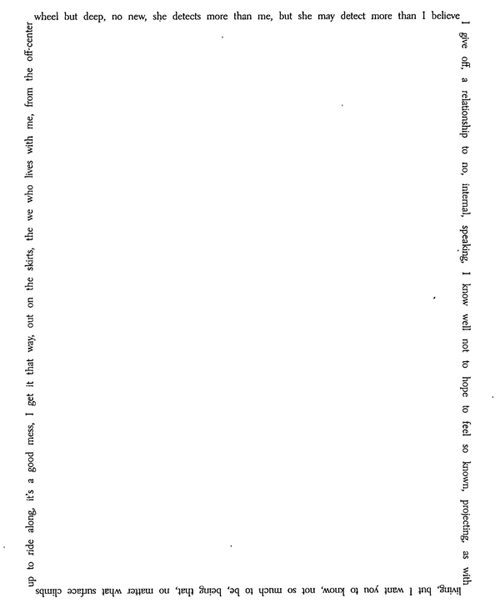Anselm Berrigan has taken it upon himself to write a book of poetry well beyond any conventional parameters. Come in Alone operates outside of whatever categorical box you might attempt to place it in, whether that may be classical or contemporary, academic or experimental. This is undoubtedly poetry but it’s not a book of poems in any conventional sense. That is to say, it is not composed of individual poems per se, yet at the same time it is not quite a book-length poem any more than it is a serial poem à la Jack Spicer. Neither is it conceptual poetry despite this being the likely first thought one might have for attempting to categorize it.
Berrigan has successfully defined his own one-shot lyric form. Flip through Come in Alone at a glance and you’ll see a lot what look to be blank pages. Every page in fact is a box of blank white space framed by a square border composed of one continuous “line” of poetry squaring back upon itself. The line has no ending and no beginning. There are no end-stops, such as periods, and there are no page numbers. Without any indication given as to where in the line one might start reading, it might seemingly just as well be anywhere. As the line turns at abrupt right angles moving around the page’s border, unless you’re comfortable reading text running sideways down a page, then upside down across the bottom, and sidewise back up, the only manageable way to read the line is to rotate the page in a clockwise motion. In other words, to begin reading turn the book any which way you like and open at will.
At first this may appear to be rather cheeky, perhaps even a cheap shot at following Ezra Pound’s dictum: “Make it New.” Keep reading, however! The realization soon dawns that indeed Berrigan pulls off something else entirely. He manages nothing less than a fresh approach towards a redefinition of how a lyrical line of poetry looks and operates upon the page. He’s busted out of the confines of the line break while not surrendering himself to the otherwise unavoidably confined terrain of the prose poem. There are few, if any, annoying bells and whistles, nothing too flashy or over-stylized. The language may best be characterized as a cross between stream-of-consciousness and found, or overheard, fragmentary hits from off the everyday conversation of sidewalk and cafe.
Here’s one of Berrigan’s lines from a page taken at random, the right angle turn at the four corners is indicated by the inserted “|”, I begin a few words in from the “top” left of the page:
“[…] she detects more than me, but she may detect more than I believe | I give off, a relationship to no, internal, speaking, I know will not to hope to feel so known, projecting, as with | living, but I want you to know, not so much to be, being that, no matter what surface climbs | up to ride along, it’s a good mess, I get it that way, out on the skirts, the we who lives with me, from the off-center | wheel but deep, no new, she detects [etc.]”
This strange continuously looping line of poetry allows for an endless series of variable readings. It is clearly understandable at one level as a love lyric in which the speaker of the poem wrangles over the promises and wishes of romantic pursuit caught up amid the daily struggles of any relationship. As such it operates well within the lineage of the poet-lover’s plaint straight from Petrarch, Dante and the Troubadours on down to Thomas Wyatt continuing to the current day. Yet without clear sequential ordering and structure, any syntactical sense nonetheless remains arbitrary at best. The otherwise stuttering oddities in sections of the line, such as “I give off, a relationship to no, internal, speaking, I know,” rather than mar or distract only contribute towards making multiple possible readings available. What would otherwise be met as nonsensical if presented in a more traditional form gains persuasive merit and rewards successive readings.
Every one of Berrigan’s lines simultaneously collapses inward while continually expanding outward. They head nowhere and everywhere in an infinite advance. The structural unit comes down to the singular word or, at times, phrase. Individual words and phrases connect up with each other from across the expanse of white upon the center of the page. The more often you read each line the more the contents of that line provoke as the eye begins to shuffle and rearrange, pick up at different “beginnings” of the line, constantly seeking new readings and alternate realizations of what’s happening. No one word or phrase is unavoidably tied to any other. The reading order of any one line gets reversed, distorted. And yet no page is ever a mere jumble of nonsensical randomness. After all, these lines are borders framing the whiteness of the empty page. It would appear Berrigan is courting his readers, encouraging them to get to work filling in that empty space. The page becomes a mirror. Write your own way across it. Disappear into the language. Reading becomes writing, more alive with every word.





